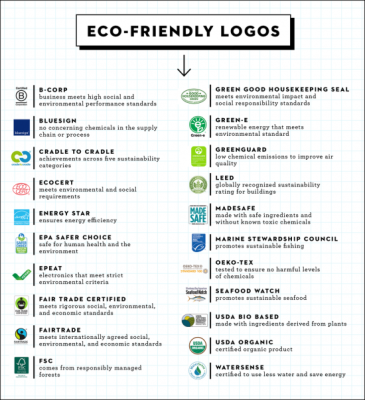What Does "Eco-Friendly" Actually Mean?
Don't fall victim to greenwashing.
The term “eco-friendly” gets thrown around a lot — you see it on labels for everything from sandwich bags to sheet sets. Since it’s used so often, it can be hard to understand the importance of eco-friendly lifestyles and products. And if you aren't sure what the word truly means, there's a greater risk of being misled by companies claiming to be conscious of the environment.
According to Merriam-Webster, the official definition of eco-friendly is: “not environmentally harmful.” When it comes to products, that means everything from production to packaging needs to be safe for the environment. But here's where it gets tricky: The FTC Green Guides say that in order for a product to be properly labeled as eco-friendly, the packaging must explain why it is environmentally responsible. Otherwise, it might not even be safe for the environment based on how consumers actually use the product. These misleading marketing claims are often called "greenwashing" (keep reading for more on that topic).
The Good Housekeeping Institute recently wrapped up its third annual Raise the Green Bar sustainability summit and the launch of our first-ever Sustainable Packaging Awards. When the Institude looks at products in its labs, it assesses them for safety, quality, ease of use, and more before sending them out to readers to test at home — that's how you know you can trust its advice and recommendations to help you decode eco-friendly claims to make smarter decisions for your household and the environment.
A cheat sheet of "eco-friendly" terms
"Environmentally friendly," "eco-friendly," and "earth-friendly" are just other words for "not environmentally harmful."
"Green" is a "casual term that people use in exchange for any word relating to eco-consciousness," says Birnur Aral, Ph.D., Director of the GH Institute's Health, Beauty, and Environmental Sciences Lab. "It's a multi-faceted term, but it generally implies better practices for both the environment and the people involved." When we surveyed over 5,000 people from our consumer panel, we found that 65% think the word "green" is synonymous to environmentally friendly and eco-conscious.
"Sustainable" and "sustainability" can be defined in many ways, but it's generally "the practice of making sure we don’t deplete the natural resources while maintaining a prospering economy for future generations," says Aral. "It is thought to have three pillars: people, planet, and profit. For a business, this means that ensuring the wealth of employees (and people related to that business) and minimizing or even reversing its environmental impacts should be as important as turning a profit for it to be sustainable in the long run."
Our environmental experts prefer to use the term “sustainable” rather than eco-friendly. Why? When it comes to product production, everything has some sort of negative impact on the environment (think: water usage, energy and product waste, etc.), and that means there really aren't products that actually fit the definition of eco-friendly. Keep in mind, when we call something sustainable, it means that a single attribute is good for the environment — not necessarily everything about the product.
How to spot (and avoid) greenwashing
Greenwashing is a term used for when a company deceptively puts eco-friendly claims (think: "environmentally friendly," "sustainable," or "green") on its product packaging. In most cases, they are broad claims without any support to back them up. Here are a few examples of deceptive claims to watch out for, according to our environmental experts:
- A bottle of laundry detergent is labeled “free of phosphates.” Since phosphates were removed from this type of product decades ago, any reputable detergent manufacturer has already phased out the ingredient. This is considered greenwashing because phosphate-free laundry detergents are already the norm.
- A comforter or sheet set is labeled “all natural.” While the product may be made with plant-based materials like bamboo, the raw materials go through a series of manufacturing processes that synthetically alters them. This claim is deceptive because “all-natural” suggests that the bedding came straight from nature. "There actually is no such thing as 'bamboo' fiber since it's really rayon," says Lexie Sachs, director of the GH Institute's Textiles Lab. "Plus, the process involves toxic chemicals that are dangerous to the workers, wildlife, and environment where it’s produced."
- A yoga mat is labeled "biodegradable" or "recyclable." Because of the conditions at landfills, these materials won't break down quickly, and you can't recycle a yoga mat with curbside pickup or even bring them to a U.S. recycling center. These claims are considered greenwashing since they state an environmental benefit, but no meaningful benefit exists.
- A company displays an environmentally-friendly symbol that doesn't exist. Watch out for fake eco-friendly symbols created by brands. Even if a product has a green logo that says "earth friendly," it means nothing if the company designed it themselves. You can find more examples of misleading environmental claims in the FTC Green Guides.
How to find products that are truly eco-friendly
When it comes to products, there are ways to "make smart and educated decisions before you purchase something new," says Sabina Wizemann, senior chemist at the GH Institute's Health, Beauty, and Environmental Sciences Lab. That's where our rigorous testing comes in — our experts help you find the products that actually work and are less harmful to the planet. "An effective product is less likely to be thrown away or replaced," which cuts down on waste, says Wizemann.
Look for products with established, third-party emblems like EcoCert Cosmos for organic cosmetics or Fair Trade Certified ingredients. Don't get greenwashed by products with false emblems and bold claims: If it sounds too good to be true, it probably is. ABove are the logos you can actually trust. They signify a certain aspect of the product is environmentally friendly.





















